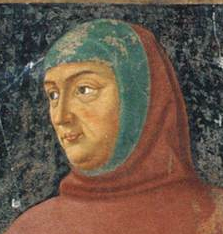 For those who aren’t historians, or literature geeks or otherwise fascinated with Italy, Petrarch may only be a familiar sounding name. The truth is the works of Francesco Petrarca (1304–74) have been overwhelmingly influential on modern times.
For those who aren’t historians, or literature geeks or otherwise fascinated with Italy, Petrarch may only be a familiar sounding name. The truth is the works of Francesco Petrarca (1304–74) have been overwhelmingly influential on modern times.
The modern Italian literary language has been shaped by Petrarch's writing, and his sonnets are a model for lyrical poetry around the world. On an even grander scale, Petrarch is sometimes called the world’s “first tourist” and credited with helping to inspire the Renaissance.
Massimo Lollini, a UO professor of Italian, values the influence of Petrarch on our art, writing and lives today, even if most of us don’t recognize it. For the past seven years, he has been working to make Petrarch’s work more accessible to a wider audience through digital technology.
Lollini is focused primarily on the Canzoniere, or Rerum vulgarium fragmenta, a collection of more than 300 poems read around the world today. Loosely translated, Rerum vulgarium fragmenta means “fragments of scattered things in vernacular.” Accordingly, Lollini, like many scholars, believes Petrarch considered the collection unfinished, an ongoing lifelong project that to this day continues to take shape—which is also how Lollini thinks readers should encounter the text.
For this reason he doesn’t consider the book-bound version of the collection an ideal form.
“If we receive Petrarch’s collection of ‘scattered’ poems in a book format, we are drawn to think of it as a finished product,” he said.
Lollini sees digital technology as a means to “reopen” the Canzoniere for reader engagement in a way Petrarch himself would have intended.
“Technology makes available a body of sources and scholarship that have historically been confined to the age of print,” he said. “It allows us to move beyond our conception of these masterpieces as completed objects of study, and instead conceive of them as ongoing projects, still alive today.”
In 2003, Lollini began taking courses in digital software for UO faculty members. It was the beginning of what became a website: “The Petrarch Project: Petrarch is again in sight,” at https://language.uoregon.edu/petrarch/.
Through the site, browsers can access Petrarch’s individual poems in a variety of translations, languages, rewritings and adaptations. Registered users provide commentary, creating a space of engagement that generates multiple ways of looking at the original source material. Its homepage declares: “Our project can be successful only if it can capture the authentic spirit of Petrarch’s cosmopolitan intellectual activity.”
Lollini thinks utilizing such technology is imperative from a practical, “get with the times” standpoint. It is changing, he says, how we read and consider literature.
— Patricia Hickson




 A new course will provide UO students with mobile smart phones and a mission: to build smart-phone apps.
A new course will provide UO students with mobile smart phones and a mission: to build smart-phone apps.
 Two CAS faculty members have been honored with the 2011 UO MLK Award.
Two CAS faculty members have been honored with the 2011 UO MLK Award. Petrarch is not only going digital at the UO, but musical as well.
Petrarch is not only going digital at the UO, but musical as well.